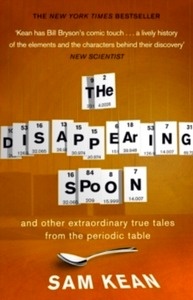The Disappearing Spoon...and other true tales from the Periodic Table

Editorial Transworld
Fecha de edición julio 2011 · Edición nº 1
Idioma inglés
EAN 9780552777506
400 páginas
Libro
encuadernado en tapa blanda
Resumen del libro
Why did Gandhi hate iodine (I, 53)? Why did the Japanese kill Godzilla with missiles made of cadmium (Cd, 48)? How did radium (Ra, 88) nearly ruin Marie Curie's reputation? And why did tellurium (Te, 52) lead to the most bizarre gold rush in history?The periodic table is one of our crowning scientific achievements, but it's also a treasure trove of passion, adventure, betrayal and obsession. The fascinating tales in The Disappearing Spoon follow carbon, neon, silicon, gold and every single element on the table as they play out their parts in human history, finance, mythology, conflict, the arts, medicine and the lives of the (frequently) mad scientists who discovered them. Why did a little lithium (Li, 3) help cure poet Robert Lowell of his madness? And how did gallium (Ga, 31) become the go-to element for laboratory pranksters? The Disappearing Spoon has the answers, fusing science with the classic lore of invention, investigation, discovery and alchemy, from the big bang through to the end of time
Biografía del autor
Sam Kean es considerado uno de los mejores escritores de divulgación científica. Su trabajo ha sido publicado en medios como The New Yorker, The Atlantic, The New York Times Magazine y Slate, entre otros, así como en la antología The Best American Nature and Science Writing y en diversos programas, como NPRx{0026} x02019;s Radiolab, Science Friday y Fresh Air. En la actualidad escribe para la revista Science, y entre sus libros destacan La cuchara menguante, El pulgar del violinista, El último aliento de César y Una historia insólita de la neurología, todos publicados por Ariel.








